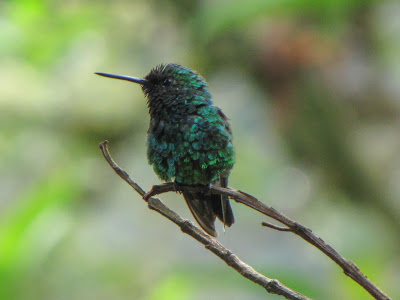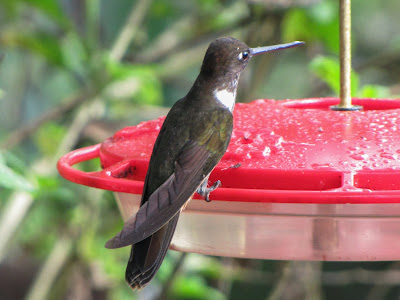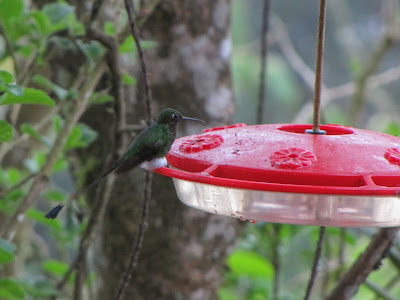On a recent field outing with the South Bend-Elkhart Audubon Society in northwest Indiana, we had an experience that reminded me of times I've spent in places like Peru, Ecuador, and Costa Rica. How is northwest Indiana anything like an amazing tropical/subtropical paradise, you ask?

Yeah, that's a parrot, one of about 20 species of feral parrots present in the United States. It sure isn't often that you see a brightly colored green, gray, and blue bird making a complete racket in the Hoosier state, but in northwest Indiana and northeastern Illinois, there are several populations of Monk Parakeets (Myiopsitta monachus) present in the wild. This clearly isn't a native species, but after having been brought into the country in the 1960s for the pet trade, Monk Parakeets began to be released into the wild, either intentionally or unintentionally. Since then, they have been able to make use of our grains, berries, nuts, and insects, as well as the urban habitats into which they were released, and their populations have survived and grown. Monk Parakeets are also present as introduced species in South America and Europe. They are considered native in southern Brazil and Bolivia into central Argentina.

Although they are unique, charismatic birds, there is question as to how their introduction might affect native bird species such as the Blue Jays and American Robins with which they compete for resources. There is also concern that they may negatively impact crops when they are present near agricultural areas. For that reason, there are laws prohibiting owning, selling, and breeding Monk Parakeets in several states. That said, it's been shown in New York that Monk Parakeet presence can reduce the number of Rock Pigeons. More recent research seems to point towards less impact as a result of the Monk Parakeet introduction, but the verdict is still out.

Monk Parakeets are the only parrot species that build their nests... er, apartments... out of sticks (all other parrots nest in cavities). Instead of living in pairs, they live and breed in large colonies in nests that can be bigger than a Smart Car. Each pair has its own entrance into the colonial nest. Below is a photo I took almost nine years ago of one of the nests from a residential area in northwest Indiana... I apologize for the awful photo quality. This nest is said to have been knocked down in a storm since I saw it.

You can see that these Monk Parakeets are hanging out on electrical power lines, and in fact, we were at an electricity substation to see them. The utility company continues to remove their nest, but these birds are persistent, and they keep trying to rebuild. As we were watching them, a chatter of eight parakeets flew off and came back carrying sticks (all but one, that is... the supervisor, we assumed). Unfortunately, these large birds and their enormous nests can cause a lot of damage. As recently as this year, a Monk Parakeet nest knocked out power in New Jersey by restricting air flow to a transformer, causing it to overheat. They can also lead to fires as they heat up as a result of being exposed to the electrical equipment.
Regardless of the fact that this is a non-native bird, it's still interesting to see how introduced species adapt to new settings, and to see such a colorful bird that can instantly take my mind away to the southern hemisphere.











